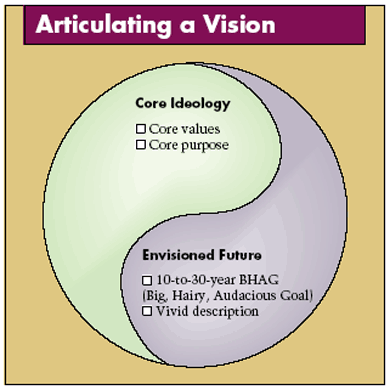
Building Your Company’s Vision
A leadership classic – the following is the 1996 Harvard Business Review article that was the seed for Jim Collins’ Good to Great, arguably one of the most influential business books in leadership circles of the church.
Companies that enjoy enduring success have core values and a core purpose that remain fixed while their business strategies and practices endlessly adapt to a changing world. The dynamic of preserving the core while stimulating progress is the reason that companies such as Hewlett-Packard, 3M, Johnson & Johnson, Procter & Gamble, Merck, Sony, Motorola, and Nordstrom became elite institutions able to renew themselves and achieve superior long-term performance. Hewlett-Packard employees have long known that radical change in operating practices, cultural norms, and business strategies does not mean losing the spirit of the HP Way—the company’s core principles. Johnson & Johnson continually questions its structure and revamps its processes while preserving the ideals embodied in its credo. In 1996, 3M sold off several of its large mature businesses—a dramatic move that surprised the business press—to refocus on its enduring core purpose of solving unsolved problems innovatively. We studied companies such as these in our research for Built to Last: Successful Habits of Visionary Companies and found that they have outperformed the general stock market by a factor of 12 since 1925.
Truly great companies understand the difference between what should never change and what should be open for change, between what is genuinely sacred and what is not. This rare ability to manage continuity and change—requiring a consciously practiced discipline—is closely linked to the ability to develop a vision. Vision provides guidance about what core to preserve and what future to stimulate progress toward. But vision has become one of the most overused and least understood words in the language, conjuring up different images for different people: of deeply held values, outstanding achievement, societal bonds, exhilarating goals, or motivating forces. We recommend a conceptual framework to define vision, add clarity and rigor to the vague and fuzzy concepts swirling around that trendy term, and give practical guidance for articulating a coherent vision within an organization. It is a prescriptive framework rooted in six years of research and refined and tested by our ongoing work with executives from a great variety of organizations around the world.
A well-conceived vision consists of two major components: core ideology and envisioned future. (See the exhibit “Articulating a Vision.”) Core ideology, the yin in our scheme, defines what we stand for and why we exist. Yin is unchanging and complements yang, the envisioned future. The envisioned future is what we aspire to become, to achieve, to create—something that will require significant change and progress to attain.
Core Ideology
Core ideology defines the enduring character of an organization—a consistent identity that transcends product or market life cycles, technological breakthroughs, management fads, and individual leaders. In fact, the most lasting and significant contribution of those who build visionary companies is the core ideology. As Bill Hewlett said about his longtime friend and business partner David Packard upon Packard’s death not long ago, “As far as the company is concerned, the greatest thing he left behind him was a code of ethics known as the HP Way.” HP‘s core ideology, which has guided the company since its inception more than 50 years ago, includes a deep respect for the individual, a dedication to affordable quality and reliability, a commitment to community responsibility (Packard himself bequeathed his $4.3 billion of Hewlett-Packard stock to a charitable foundation), and a view that the company exists to make technical contributions for the advancement and welfare of humanity. Company builders such as David Packard, Masaru Ibuka of Sony, George Merck of Merck, William McKnight of 3M, and Paul Galvin of Motorola understood that it is more important to know who you are than where you are going, for where you are going will change as the world around you changes. Leaders die, products become obsolete, markets change, new technologies emerge, and management fads come and go, but core ideology in a great company endures as a source of guidance and inspiration.
Core ideology provides the glue that holds an organization together as it grows, decentralizes, diversifies, expands globally, and develops workplace diversity. Think of it as analogous to the principles of Judaism that held the Jewish people together for centuries without a homeland, even as they spread throughout the Diaspora. Or think of the truths held to be self-evident in the Declaration of Independence, or the enduring ideals and principles of the scientific community that bond scientists from every nationality together in the common purpose of advancing human knowledge. Any effective vision must embody the core ideology of the organization, which in turn consists of two distinct parts: core values, a system of guiding principles and tenets; and core purpose, the organization’s most fundamental reason for existence.
Core Values
Core values are the essential and enduring tenets of an organization. A small set of timeless guiding principles, core values require no external justification; they have intrinsic value and importance to those inside the organization. The Walt Disney Company’s core values of imagination and wholesomeness stem not from market requirements but from the founder’s inner belief that imagination and wholesomeness should be nurtured for their own sake. William Procter and James Gamble didn’t instill in P&G’s culture a focus on product excellence merely as a strategy for success but as an almost religious tenet. And that value has been passed down for more than 15 decades by P&G people. Service to the customer—even to the point of subservience—is a way of life at Nordstrom that traces its roots back to 1901, eight decades before customer service programs became stylish. For Bill Hewlett and David Packard, respect for the individual was first and foremost a deep personal value; they didn’t get it from a book or hear it from a management guru. And Ralph S. Larsen, CEO of Johnson & Johnson, puts it this way: “The core values embodied in our credo might be a competitive advantage, but that is not why we have them. We have them because they define for us what we stand for, and we would hold them even if they became a competitive disadvantage in certain situations.”
The point is that a great company decides for itself what values it holds to be core, largely independent of the current environment, competitive requirements, or management fads. Clearly, then, there is no universally right set of core values. A company need not have as its core value customer service (Sony doesn’t) or respect for the individual (Disney doesn’t) or quality (Wal-Mart Stores doesn’t) or market focus (HP doesn’t) or teamwork (Nordstrom doesn’t). A company might have operating practices and business strategies around those qualities without having them at the essence of its being. Furthermore, great companies need not have likable or humanistic core values, although many do. The key is not what core values an organization has but that it has core values at all.
Companies tend to have only a few core values, usually between three and five. In fact, we found that none of the visionary companies we studied in our book had more than five: most had only three or four. And, indeed, we should expect that. Only a few values can be truly core—that is, so fundamental and deeply held that they will change seldom, if ever.
Read the rest of the article here.
Read more from Jim here.

Tags: Jim Collins, Strategy, Values, Vision Frame












